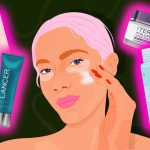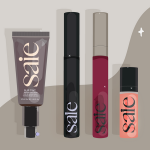So You Want To… Get a Hollywood Smile?
Dr. Sharon Huang: Dentist
-
Beauty IRL

“We want pearly whites.” We’ve been saying that since 7th grade when we first saw a commercial do the napkin test. But after trying all the tricks and not-so-fun home hacks, we’re getting professional advice from Dr. Sharon Huang (she / her), the founder of Les Belles NYC.
Here, the 36-year-old dentist explains the best ways to get a blinding smile, how she’s shaking up the veneer game, and which DIY methods to avoid. (Hint: When life gives you lemons, make lemonade, not a whitening paste.)
How do our teeth get stained or darkened in the first place?
Anything that’s going to stain your white t-shirt will stain your teeth. Think about everything we put in our mouths—tomato sauce, red wine, strawberries, blueberries, blackberries… They have color particles in them, and the color gets into these little grooves of your teeth and [makes them] dull. The process of whitening is simply having the material bond to the stain and pull the stain off. It’s like putting a Tide pen on a white t-shirt.
Are at-home whitening products just as effective as going to the dentist?
The whitening products over the counter are like pain medications. You can get 200 milligrams of ibuprofen, but you can’t get 1,000. It’s not safe for the public. Whatever’s on the market for whitening is below a certain threshold of concentration. What we use in the office [gives] deeper penetration into the teeth.
What’s the best whitening option for people with sensitive teeth or thin enamel?
I would stay away from whitening toothpaste because the way it whitens is with abrasives, which will work, but you’re also scrubbing your enamel and you don’t want that. It’s always best to do an effective in-office whitening to get the medium and deep stains out, and then maintain the superficial stains with whitening strips.
What whitening strip brands do you suggest?
Burst has a really good whitening strip that I love. Oral Essentials has a non-peroxide organic strip, [and] Spotlight has good strips. Like everything else in life, you [have to] look at the label. If you can’t read the label, then there’s a lot of fillers. Boutique brands have more soothing ingredients. The Burst strips have coconut oil, which will soothe your teeth and help with sensitivity. People who want a more natural whitening system can use coconut oil. It’s effective over time but you need a lot of patience [because] you have to leave it in your mouth for like 20 minutes.
There are so many home remedies for whitening. Which should we avoid?
Lemon! Do not put anything acidic in your mouth to bathe your teeth in because that will cause decalcification. It will weaken the enamel and could cause other problems, and it will not whiten your teeth. Charcoal is a big no-no—it’s very abrasive and harms the enamel over time. Things that will whiten your teeth [are] coconut oil and baking soda.
How can we protect our enamel while whitening our teeth?
There are a lot of toothpastes out there that have desensitizers in them. Any products with aloe vera are good to soothe the gums and the teeth while you’re whitening, but look for sensitive toothpaste. A commercial brand [is] Sensodyne, and then a lot of the boutique brands like Hello have [toothpaste] for sensitive teeth.
We watch Love Island UK, so we know veneers are like the whitest teeth you could ever get. When should we consider those?
It’s an option [for] patients with really deep, intrinsic stains who are just not happy with the color. People who have small teeth, gaps, or want a uniform color [or] texture are the patients getting veneers.
You developed a technique to improve the veneers process. Can you tell us about it?
Typically when patients get veneers, they pay for it and then come in for a long appointment where you see what your veneers are going to look like for the first time. The veneer is an art, but everyone’s art is different, so a lot of times patients are like, “I didn’t think they were going to look like this,” but it’s already too late. So I’m like, “How can I make this more predictable? How can I show them what it’s going to look like before they commit to it?”
What was your answer?
What I’ve been doing with The Smile Preview is handmaking the design I think will work on someone’s face, scalping it with a paintbrush on their teeth, and then they’re able to see what it’ll look like without me cutting their teeth.. [It’s] 100% reversible. I take pictures of it, pop it right off, and then they go home and make a decision. It does require a lot more time on my part, but that’s the best thing we could do for patients.



